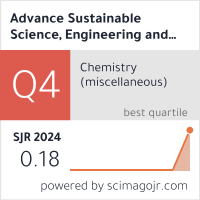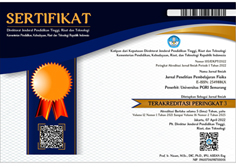Comparative Analysis of Observed and Empirical Rainfall Distribution for Flood Hydrograph Modeling
DOI:
https://doi.org/10.26877/asset.v7i3.2142Keywords:
Empirical Rainfall, Flood Modeling, HEC-HMS, Observed Rainfall, SCS-CN, Rainfall-RunoffAbstract
Flood disasters in Indonesia are persistent challenges during the rainy season, primarily due to intense rainfall and inadequate flood control. This study evaluates hourly rainfall to characterize hydrology and predict flood discharge more accurately, benefiting water infrastructure planning. The research used modified Mononobe methods, observational data, and rainfall-runoff modeling, including HEC-HMS simulations with the SCS-CN unit hydrograph. Observed rainfall simulated a flood discharge of 779.7 m³/s, while empirical rainfall yielded 3623 m³/s, showing a 79.12% deviation. Comparing flood hydrographs, recorded rainfall data closely matched previous studies (R² = 0.94), unlike empirical rainfall (R² = 0.88). The study concludes that observed rainfall is highly effective for estimating flood runoff, accurately representing local characteristics. This method significantly aids planning and design of water resource infrastructure like dams, weirs, and bridges at the study site.
References
[1] Hengkelare SHS, Rogi OHA, Suryono. Mitigasi risiko bencana banjir di Manado. Jurnal Spasial 2021;8:267–74.
[2] Daniil EI, Michas S. Hydrologic modeling for the determination of design discharges in ungauged basins. Global NEST Journal 2018;7:296–305. https://doi.org/10.30955/gnj.000381.
[3] Bezak N, Šraj M, Rusjan S, Mikoš M. Impact of the rainfall duration and temporal rainfall distribution defined using the Huff curves on the hydraulic flood modelling results. Geosciences (Switzerland) 2018;8. https://doi.org/10.3390/geosciences8020069.
[4] Pujiastuti R, Kumala NRD. Analisa Sensitivitas Durasi Hujan pada Perhitungan Debit Banjir DAS Tenggang dan Sringin. Semarang: 2022.
[5] Marra F, Nikolopoulos EI, Anagnostou EN, Morin E. Metastatistical Extreme Value analysis of hourly rainfall from short records: Estimation of high quantiles and impact of measurement errors. Advances in Water Resources 2018;117:27–39. https://doi.org/10.1016/j.advwatres.2018.05.001.
[6] Amal N, Hendra, Winata A. Pengaruh Distribusi Hujan Terhadap Perhitungan Debit Banjir pada Daerah Rawa di DAS Martapura. Kacapuri 2023;6:217–31.
[7] Libertino A, Allamano P, Laio F, Claps P. Regional-scale analysis of extreme precipitation from short and fragmented records. Advances in Water Resources 2018;112:147–59. https://doi.org/10.1016/j.advwatres.2017.12.015.
[8] Ginting S. The Development of Planning Rainfall Hyetograph in Bekasi City. Jurnal Sumber Daya Air n.d.;19:102–13.
[9] BWS Nusa Tenggara 1. Rencana Tindak Darurat Bendungan Tiu Suntuk. Sumbawa Barat: 2020.
[10] Sosrodarsono S, Kensaku T. Hidrologi untuk Pengairan. Jakarta: Pradnya Paramita; 2003.
[11] Luo J, Zheng Z, He S, Ding W. Multi-temporal spatial modelling to assess runoff and sediment dynamics under different microtopographic patterns. Geoderma 2023;436:116539. https://doi.org/10.1016/j.geoderma.2023.116539.
[12] Rahmani RN, Wahyudi AH, Sobriyah. Transformasi hujan harian ke hujan jam-jaman menggunakan metode mononobe dan pengalihragaman hujan aliran (studi kasus di DAS Tirtomoyo). Matriks Teknik Sipil 2016:176–85.
[13] Maitsa TR, Kuntoro AA, Septiadi D. Analisis Tren Perubahan Intensitas Hujan (Studi Kasus: Jakarta dan Bogor). Jurnal Teknik Sipil 2021;28:163–72. https://doi.org/10.5614/jts.2021.28.2.5.
[14] Pratiwi DW, Satria Negara A. Perbandingan Pola Distribusi Hujan Terukur dan Metode Empiris dalam Perhitungan Debit Banjir Rencana DAS Jurug. Jurnal Teknik Sumber Daya Air 2023;3:29–42. https://doi.org/10.56860/jtsda.v3i1.55.
[15] Darsono S, Kodoatie RJ, Afifah RC, Lestari FM, Suryani L. Upaya Reduksi Bencana Banjir Kota Taliwang 2022:28–9.
[16] Pheaktra N, Istiarto I, Jayadi R. Urban Flood Control in Sringin Catchment, Semarang City, Central Java Province, Indonesia. Journal of the Civil Engineering Forum 2018;4:191. https://doi.org/10.22146/jcef.33886.
[17] Nurhidayah R. Pola Distribusi Hujan Jam-jaman di DAS Tandon Bagian Hulu. Univerditas Sebelas Maret Surakarta, 2010.
[18] Takeda SS& K. Hidrologi untuk Pengairan. PT. Pradnya Paramitha, Jakarta.; 1993.
[19] Dantje K. Natakusumah, Waluyo Hatmoko DH. Prosedur Umum Perhitungan Hidrograf Satuan Sintetis dengan Cara ITB dan Beberapa Contoh Penerapannya. Jurnal Teknik Sipil 2011;18:251–91.
[20] Tikno S, Hariyanto T, Anwar N, Karsidi A, Aldrian E. Aplikasi Metode Curve Number Untuk Mempresentasikan Hubungan Curah Hujan Dan Aliran Permukaan Di Das Ciliwung Hulu – Jawa Barat. Jurnal Teknologi Lingkungan 2016;13:25. https://doi.org/10.29122/jtl.v13i1.1402.
[21] Triatmodjo B. Hidrologi Terapan. Yogyakarta: Beta Offset; 2008.
[22] Soemarto CD. Hidrologi Teknik. Jakarta: Erlangga.; 1995.
[23] Labambe M. Predicting Waste Production Trends in Palu City Using Linear Regression Analysis. Advance Sustainable Science Engineering and Technology 2024;6:0240306. https://doi.org/10.26877/asset.v6i3.523.
[24] Hardy A, Rohmawati A, Prasetyowati S. Prediction of Bandung City Traffic Classification Using Machine Learning and Spatial Analysis. Media Inform Budidharma 2022;6:1861.
[25] Soulis KX. Soil conservation service curve number (SCS-CN) method: Current applications, remaining challenges, and future perspectives. Water (Switzerland) 2021;13. https://doi.org/10.3390/w13020192.
[26] Kumar A, Kanga S, Taloor AK, Singh SK, Đurin B. Surface runoff estimation of Sind river basin using integrated SCS-CN and GIS techniques. HydroResearch 2021;4:61–74. https://doi.org/10.1016/j.hydres.2021.08.001.
[27] BWS Nusa Tenggara 1. Laporan Akhir Pengelolaan Bendungan. Mataram: 2021.
[28] Kementerian PUPR. Modul Operasi Waduk Pelatihan Alokasi Air. Pusat Pendidikan Dan Pelatihan Sumber Daya Air Konstruksi 2017:67.











